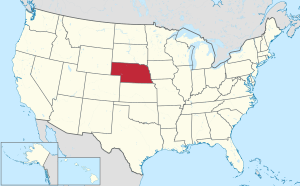Furnas County, Nebraska
Furnas County | |
|---|---|
 Furnas County Courthouse in Beaver City | |
 Location within the U.S. state of Nebraska | |
 Nebraska's location within the U.S. | |
| Coordinates: 40°10′N 99°55′W / 40.17°N 99.91°W | |
| Country | |
| State | |
| Founded | 1873 |
| Named for | Robert W. Furnas |
| Seat | Beaver City |
| Largest city | Cambridge |
| Area | |
| • Total | 721 sq mi (1,870 km2) |
| • Land | 719 sq mi (1,860 km2) |
| • Water | 1.5 sq mi (4 km2) 0.2% |
| Population (2010) | |
| • Total | 4,959 |
| • Density | 6.9/sq mi (2.7/km2) |
| Time zone | UTC−6 (Central) |
| • Summer (DST) | UTC−5 (CDT) |
| Congressional district | 3rd |
| Website | www |
Furnas County is a county in the U.S. state of Nebraska. As of the 2010 census, the population was 4,959.[1] Its county seat is Beaver City.[2] The county was named in honor of Robert W. Furnas, the second governor of the state of Nebraska.[3]
In the Nebraska license plate system, Furnas County is represented by the prefix 38 (it had the thirty-eighth-largest number of vehicles registered in the county when the license plate system was established in 1922).
Geography
According to the U.S. Census Bureau, the county has an area of 721 square miles (1,870 km2), of which 719 square miles (1,860 km2) is land and 1.5 square miles (3.9 km2) (0.2%) is water.[4]
Major highways
 U.S. Highway 6
U.S. Highway 6 U.S. Highway 34
U.S. Highway 34 U.S. Highway 136
U.S. Highway 136 U.S. Highway 283
U.S. Highway 283 Nebraska Highway 46
Nebraska Highway 46 Nebraska Highway 47
Nebraska Highway 47 Nebraska Highway 89
Nebraska Highway 89
Adjacent counties
- Harlan County (east)
- Norton County, Kansas (south)
- Decatur County, Kansas (southwest)
- Red Willow County (west)
- Frontier County (northwest)
- Gosper County (north)
- Phelps County (northeast)
Demographics
| Census | Pop. | Note | %± |
|---|---|---|---|
| 1880 | 6,407 | — | |
| 1890 | 9,840 | 53.6% | |
| 1900 | 12,373 | 25.7% | |
| 1910 | 12,083 | −2.3% | |
| 1920 | 11,657 | −3.5% | |
| 1930 | 12,140 | 4.1% | |
| 1940 | 10,098 | −16.8% | |
| 1950 | 9,385 | −7.1% | |
| 1960 | 7,711 | −17.8% | |
| 1970 | 6,897 | −10.6% | |
| 1980 | 6,486 | −6.0% | |
| 1990 | 5,553 | −14.4% | |
| 2000 | 5,324 | −4.1% | |
| 2010 | 4,959 | −6.9% | |
| 2015 (est.) | 4,862 | [5] | −2.0% |
| U.S. Decennial Census[6] 1790-1960[7] 1900-1990[8] 1990-2000[9] 2010-2013[1] | |||
As of the census[10] of 2000, there were 5,324 people, 2,278 households, and 1,489 families residing in the county. The population density was 7 people per square mile (3/km²). There were 2,730 housing units at an average density of 4 per square mile (1/km²). The racial makeup of the county was 98.22% White, 0.08% Black or African American, 0.41% Native American, 0.23% Asian, 0.32% from other races, and 0.75% from two or more races. 1.15% of the population were Hispanic or Latino of any race. 45.6% were of German, 13.8% American, 11.4% English, 7.4% Irish and 5.2% Swedish ancestry according to Census 2000.
There were 2,278 households out of which 28.00% had children under the age of 18 living with them, 57.20% were married couples living together, 5.90% had a female householder with no husband present, and 34.60% were non-families. 32.50% of all households were made up of individuals and 19.80% had someone living alone who was 65 years of age or older. The average household size was 2.28 and the average family size was 2.88.
In the county the population was spread out with 24.10% under the age of 18, 5.30% from 18 to 24, 22.80% from 25 to 44, 23.90% from 45 to 64, and 23.80% who were 65 years of age or older. The median age was 44 years. For every 100 females there were 92.30 males. For every 100 females age 18 and over, there were 88.00 males.
The median income for a household in the county was $30,498, and the median income for a family was $37,000. Males had a median income of $26,563 versus $19,918 for females. The per capita income for the county was $17,223. About 6.90% of families and 10.60% of the population were below the poverty line, including 14.50% of those under age 18 and 10.50% of those age 65 or over.
Communities
- Arapahoe
- Beaver City (county seat)
- Cambridge
- Edison
- Hendley
- Holbrook
- Oxford (partial)
- Wilsonville
See also
References
- ^ a b "State & County QuickFacts". United States Census Bureau. Retrieved September 19, 2013.
- ^ "Find a County". National Association of Counties. Retrieved 2011-06-07.
- ^ Gannett, Henry (1905). The Origin of Certain Place Names in the United States. Govt. Print. Off. p. 133.
- ^ "2010 Census Gazetteer Files". United States Census Bureau. August 22, 2012. Retrieved December 7, 2014.
- ^ "County Totals Dataset: Population, Population Change and Estimated Components of Population Change: April 1, 2010 to July 1, 2015". Retrieved July 2, 2016.
- ^ "U.S. Decennial Census". United States Census Bureau. Retrieved December 7, 2014.
- ^ "Historical Census Browser". University of Virginia Library. Retrieved December 7, 2014.
- ^ "Population of Counties by Decennial Census: 1900 to 1990". United States Census Bureau. Retrieved December 7, 2014.
- ^ "Census 2000 PHC-T-4. Ranking Tables for Counties: 1990 and 2000" (PDF). United States Census Bureau. Retrieved December 7, 2014.
- ^ "American FactFinder". United States Census Bureau. Retrieved 2008-01-31.

